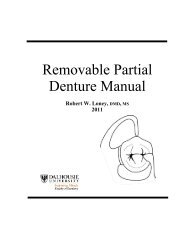Manuals_files/CD Manual 12.pdf - Removable Prosthodontics
Manuals_files/CD Manual 12.pdf - Removable Prosthodontics
Manuals_files/CD Manual 12.pdf - Removable Prosthodontics
Create successful ePaper yourself
Turn your PDF publications into a flip-book with our unique Google optimized e-Paper software.
Delivery & Adjustments - 68<br />
11. Set the maxillary denture aside and repeat for the mandibular denture. Have an assistant<br />
(classmate) in your office remount the maxillary denture using the remount index and<br />
jig, if the laboratory has not done so. Polish any areas of adjustment with pumice on a<br />
wet ragwheel and tin oxide on a dry ragwheel. Use sterile ragwheels and new pumice for<br />
each patient.<br />
12. Check the occlusion. Insert both dentures, place a cotton roll between the posterior teeth<br />
on both sides and have the patient bite forcefully for one minute. This will simulate<br />
compression of the tissue after the patient has worn the denture for a period of time.<br />
Then place the patient in centric relation and visually check the occlusion. Stabilize the<br />
mandibular denture, using index fingers on the facial surface of mandibular denture and<br />
thumbs under mandible.<br />
14. If there appears to be an open bite or very unstable posterior contacts, the heels of the<br />
dentures or the occlusal contacts may require adjustment. Use articulating film to mark<br />
the interferences and adjust the dentures to provide stable bilateral contacts.<br />
Clinical Remount for Occlusal Adjustment<br />
- A clinical remount involves remounting the processed dentures on an articulator for the<br />
purposes of adjusting the occlusion extraorally<br />
- Overall, the clinical remount can save time - there will be fewer subsequent adjustment<br />
appointments, and the operator doesn't have to continually remove and replace the<br />
dentures intraorally during the adjustment procedure<br />
- Clinical remounting allows identification of interferences that may not be seen<br />
intraorally, since occlusal interferences can cause pain or instability of the dentures.<br />
when this occurs, patients reflexly avoid the interferences, so that the problem may be<br />
difficult to identify<br />
- While not all dentures will require an occlusal remount, we will routinely remount<br />
dentures over the course of the next several years, so that you become proficient in<br />
this procedure. All dentures with cusped tooth forms and any dentures with 0° tooth<br />
form and a demonstrated centric record occlusal discrepancy should be remounted,<br />
and the denture occlusion be adjusted for centric and excursive contacts on the<br />
articulator.















